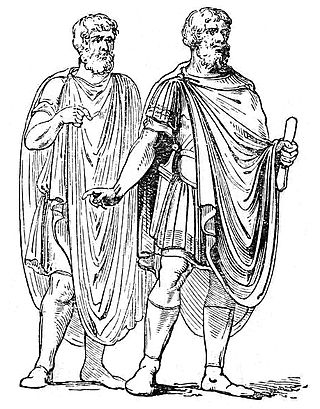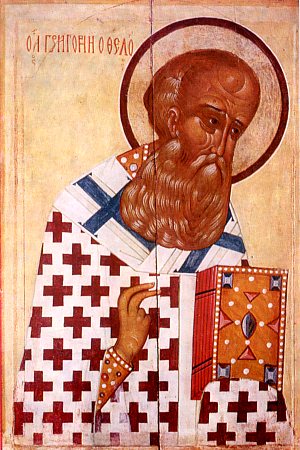Related Research Articles
LacusCurtius is a website specializing in ancient Rome, currently hosted on a server at the University of Chicago. It went online on August 26, 1997; in November 2023 it had "3916 webpages, 779 photos, 772 drawings & engravings, 120 plans, 139 maps." The site is the creation of William P. Thayer.

Sir William Smith was an English lexicographer. He became known for his advances in the teaching of Greek and Latin in schools.

A Dictionary of Greek and Roman Antiquities is an English language encyclopedia first published in 1842. The second, improved and enlarged, edition appeared in 1848, and there were many revised editions up to 1890. The encyclopedia covered law, architecture, warfare, daily life, and similar subjects primarily from the standpoint of a classicist. It was one of a series of reference works on classical antiquity by William Smith, the others cover persons and places. It runs to well over a million words in any edition, and all editions are now in the public domain.
An ala was the term used during the middle of the Roman Republic to denote a military formation composed of conscripts from the socii, Rome's Italian military allies. A normal consular army during the period consisted of two legions, composed of only Roman citizens, and two allied alae.

An abolla was a cloak-like garment worn by ancient Greeks and Romans. Nonius Marcellus quotes a passage of Varro to show that it was a garment worn by soldiers, and thus opposed to the toga. Roman women also wore a version of the abolla by at least the Imperial Period.

Apamea Cibotus, Apamea ad Maeandrum, Apamea or Apameia was an ancient city in Anatolia founded in the 3rd century BC by Antiochus I Soter, who named it after his mother Apama. It was in Hellenistic Phrygia, but became part of the Roman province of Pisidia. It was near, but on lower ground than, Celaenae (Kelainai).

The Doric or Dorian Hexapolis was a federation of six cities of Dorian foundation in southwest Asia Minor and adjacent islands, largely coextensive with the region known as Doris or Doris in Asia, and included:

Nazianzus or Nazianzos, also known as Nandianulus, was a small town of ancient Cappadocia, and in the late Roman province of Cappadocia Tertia, located 24 Roman miles to the southeast of Archelais. In the Jerusalem Itinerary it is miswritten as Nathiangus.

In classical antiquity, a crotalum was a kind of clapper or castanet used in religious dances by groups in ancient Greece and elsewhere, including the Korybantes.

Dorothy, Lady Pakington was an English friend and supporter of learned clergymen, and a writer of religious works. She was for many years reputed to be the author of The Whole Duty of Man. She enjoyed the esteem and friendship of the most eminent divines of her time. Dr. Henry Hammond resided at her home for several years.
In Greek mythology, Aenete was the daughter of Eusorus, and wife of Aeneus, by whom she had a son, Cyzicus, the founder of the town of this name. In some traditions she is called Aenippe.
Aetna was in Greek and Roman mythology a Sicilian nymph and, according to Alcimus, a daughter of Uranus and Gaia or of Briareus. Stephanus of Byzantium says that according to one account Aetna was a daughter of Oceanus. Simonides said that she had acted as arbitrator between Hephaestus and Demeter respecting the possession of Sicily. By Zeus or Hephaestus she became the mother of the Palici.

Edward Bishop Elliott was an English clergyman, preacher and premillennarian writer.
Temnos or Temnus was a small Greek polis (city-state) of ancient Aeolis, later incorporated in the Roman province of Asia, on the western coast of Anatolia. Its bishopric was a suffragan of Ephesus, the capital and metropolitan see of the province, and is included in the Catholic Church's list of titular sees.
Alexander II, or Alexander Maccabeus, was the eldest son of Aristobulus II, king of Judaea. He married his cousin Alexandra Maccabeus, daughter of his uncle, Hyrcanus II. Their grandfather was Alexander Jannaeus, the second eldest son of John Hyrcanus. Mariamne, the daughter of Alexander and Alexandra, was Herod the Great's second wife and Hasmonean queen of the Jewish kingdom.
The aes uxorium was a Roman tax paid by those who reached adulthood without marrying, with the exception of the Vestal Virgins.
The aes equestre was an allotment paid during the Roman Republic to each cavalryman to provide him with a horse. This was said to have been instituted by Servius Tullius as part of his reorganization of the military. This allotment was 10,000 asses, to be given to the Equus publicus out of the public treasury of Rome. A similar allotment, the aes hordearium paid for the horses' upkeep, and was funded by a tax of 2,000 ases annually on unmarried women and orphans possessing a certain amount of property

Minnie Mary Lee was a pen name of Julia Amanda Sargent Wood, a 19th-century American sentimental author, of poems, stories, sketches and novels, who sometimes also wrote as Mrs. Julia A. A. Wood. She began writing very early in life, but did not publish in book form until she was in her forties. The Heart of Myrrha Lake, Or, Into the Light of Catholicity ; Hubert's Wife: a Story for You ; The Brown House at Duffield: a Story of Life without and within the Fold ; and The Story of Annette and her Five Dolls: Told to dear little Catholic Children were her published works. A convert to Roman Catholicism, Wood's novels were on Catholic themes.
Damalis was a coastal town of ancient Bithynia located on the Bosphorus near Chrysopolis. Polybius calls the town Bus or Bous.
Helen Chadwick Thayer was an American suffragist and social reformer. A pioneer in the settlement movement era, she was a co-founder and president of the College Settlements Association (CSA). She was an alumnæ trustee of Smith College.
References
- ↑ Livy; Foster, Benjamin O. (tr.). The History of Rome 1.43.9 . Retrieved Nov 9, 2019.
- ↑ Cic. de Rep. II.20.
- ↑ Gaius, l.c.)
- ↑ "LacusCurtius: How the Roman Army Was Paid (Smith's Dictionary, 1875)". University of Chicago . Retrieved 28 September 2016.
 This article incorporates text from this source, which is in the public domain .
This article incorporates text from this source, which is in the public domain .